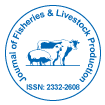Assessing Sustainable Fishing Yields Using Length-based Analytical Models: A Case Study with Nile Tilapia in Lake Hawassa (Ethiopia)
Received Date: Oct 11, 2017 / Accepted Date: Dec 14, 2017 / Published Date: Dec 16, 2017
Abstract
Nile Tilapia, Oreochromis niloticus, is one of important commercial fish in Africa and other tropical regions. In Ethiopia, it accounts for more than 60% of the total annual landings. In Lake Hawassa, one of the rift valley lakes in Ethiopia, it even mounts to more than 85%. However, recently, the yield in the lake dropped to about 50% of its historical maximum, indicative of a dwindling population size resulting from overfishing. This research aimed at assessing the sustainable potential yield of tilapia in Lake Hawassa. Data were collected for one year, on a daily basis, from the commercial fishery. The growth parameters (L∞ and K), the total population (N) and the fishing mortality (F) were estimated using FiSAT II. The maximum sustainable and economic yields (MSY & MEY) and the corresponding fishing effort were determined using the length-based Thompson & Bell bio-economic model. Accordingly, the MSY was estimated at 466.3 tonnes per year. Our findings will be instrumental to prepare a fishery management plan for the lake. The procedure can also be applied to assess the fish stock of the other rift valley lakes.
Keywords: Fish stock assessment; Fishery management; Lake Hawassa; Maximum sustainable yield; Nile Tilapia; Overfishing
Citation: Alemu Y, Snoeks J, Teklegiorgis Y, Nyssen J, Brendonck L (2017) Assessing Sustainable Fishing Yields Using Length-based Analytical Models: A Case Study with Nile Tilapia in Lake Hawassa (Ethiopia). J Fisheries Livest Prod 5: 255. Doi: 10.4172/2332-2608.1000255
Copyright: © 2017 Alemu Y, et al. This is an open-access article distributed under the terms of the Creative Commons Attribution License, which permits unrestricted use, distribution, and reproduction in any medium, provided the original author and source are credited.
Share This Article
Recommended Journals
Open Access Journals
Article Tools
Article Usage
- Total views: 6215
- [From(publication date): 0-2017 - Apr 26, 2025]
- Breakdown by view type
- HTML page views: 5174
- PDF downloads: 1041
